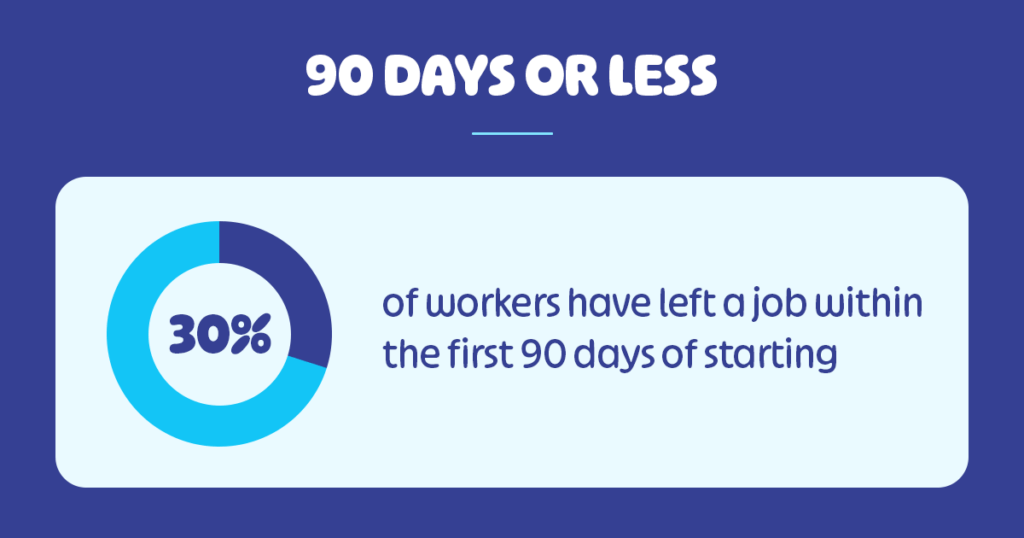Welcome to the ultimate guide on automating your employee onboarding process! If you’re new to this concept, don’t worry—this guide is designed to walk you through everything you need to know to make onboarding easier, more efficient, and much more enjoyable for your new hires.
What is onboarding automation?
Let’s start with the basics.
Onboarding automation is all about creating a structured and streamlined experience that guides new hires through every step of your onboarding program without the hassle of manual effort. Imagine being able to set up training programs, send reminders, connect new employees with their colleagues, and more—all with a system that works automatically.
Sounds great, right? That’s because it is!
The benefits of automated onboarding
Automating your onboarding process comes with a host of benefits that can transform the way your business operates. Here are some key advantages:
- Consistency and Quality: Automation ensures that every new hire receives the same high-quality onboarding experience. No more missed steps or forgotten documents.
- Time Efficiency: By automating repetitive tasks, your HR team can save significant time and focus on more strategic activities that add real value to the company.
- Enhanced Employee Experience: A smooth, engaging onboarding process helps new hires feel welcome and valued, boosting morale and retention.
- Faster Time-to-Productivity: Automated onboarding ensures new employees have all the information and training they need from day one, helping them to get up to speed quickly.
- Cost Savings: Reducing the manual workload translates to lower operational costs and better use of resources.
Automate onboarding flows before your new hire even walks through the door. You’ll be setting them, the hiring manager and the business up for success.
With automation, there’s no more need to focus on paperwork. Automation consequently creates space to focus on connection and culture integration, which are arguably the most important elements of onboarding.
Automated Onboarding and the 5C's
The quality and success of an onboarding process can often be measured by the framework known as the "5C’s": Compliance, Clarification, Culture, Connection, and Check-back. Automated onboarding systems can effectively enhance each of these critical elements, ensuring a comprehensive and robust onboarding experience for new employees.
1. Compliance
Automated onboarding ensures that all necessary regulatory and legal requirements are met efficiently. The system can guide new hires through compulsory documentation training sessions on workplace policies and safety protocols, ensuring full compliance with minimal oversight from HR personnel.
2. Clarification
Clear communication of job roles and expectations is crucial for new employee integration. Automated platforms can deliver standardized training modules, detailed role descriptions, and performance metrics, enabling new hires to understand their responsibilities and objectives from the outset.
3. Culture
Integrating new employees into the company culture is pivotal for long-term retention and engagement. Automated onboarding solutions often include interactive elements such as virtual office tours, introductions to team members, and cultural orientation videos that help new hires acclimate to the business’s ethos and values.
4. Connection
Building connections within the team and the organization at large promotes a supportive work environment. Automated systems can facilitate introductions to mentors, schedule meetings with key team members, and set up collaborative platforms where new hires can reach out for support, fostering a sense of belonging and community.
5. Check-back
Ongoing support and feedback are essential for continual growth and improvement. Automated onboarding can include regular check-ins and surveys to gauge the new hire’s comfort level and progress, enabling HR managers to address any issues promptly and adjust the onboarding process as needed.
By utlizing the 5C framework within an automated onboarding system, businesses can create an efficient, and engaging onboarding experience that sets up new employees for success from day one.
An example of automated onboarding in practice
Rihm Family Companies, Inc. (RFC) is a 4th-generation family-owned and operated business in the heavy-duty truck industry. With over 350 employees across 21 locations, RFC needed a solution to centralize its Standard Operating Procedures (SOPs) and streamline the training and onboarding process.
Whale's Solution
RFC partnered with Whale, an AI-powered platform designed to create and centralize company processes. Whale’s automated training flows were used to onboard new team members, providing each employee with access to their department’s relevant information without overwhelming them with unnecessary details.
The Results
The implementation of Whale’s onboarding system led to several key benefits for RFC:
All company information was broken down into easy-to-consume pieces, ensuring new hires received the right information at the right time.
The onboarding process became more efficient and consistent, reducing the time and effort required from HR and new employees.
New hires felt more engaged and supported, leading to better integration and faster productivity.

Examples of automated employee onboarding
To give you a clearer picture, here are some specific examples of how automated onboarding can be applied in different business scenarios:
- Welcome Emails and Information Packets: Automatically send a welcome email to new hires with all the necessary information about their first day, company culture, and policies. This email can include links to digital versions of employee handbooks.
- Training Modules: Set up a series of training modules that new hires can complete at their own pace. This could include videos, quizzes, and interactive content to keep them engaged.
- Buddy Systems: Automatically assign new hires onboarding buddies. These buddies can help them find their way during the first few weeks and answer any questions they might have.
- Document Management: Automate the creation, distribution, and collection of onboarding documents. Use integrations with tools like DocuSign to streamline signatures and approvals.
- Progress Tracking: Monitor the progress of new hires through automated tracking systems. Schedule regular check-ins with new hires to help them stay on track and to provide feedback for the onboarding process.
Manual vs. automated onboarding
You might be wondering how automated onboarding compares to the traditional manual process.
Let’s break it down:
- Manual Onboarding: Typically involves a lot of paperwork, disjointed processes and can be and prone to errors. It’s easy for new hires to feel overwhelmed and for HR teams to get bogged down in administrative tasks.
- Automated Onboarding: Provides a streamlined, consistent experience. With Whale, you reduce the administrative burden and ensuring nothing falls through the cracks.
How to automate employee onboarding with Whale
Ready to get started? Here are some steps to help you automate your employee onboarding process with Whale:
- Choose the Right Software: Select an AI-powered onboarding platform like Whale that fits your business needs. Look for features such as task automation, document management, and integration with your existing HR systems.
- Train Your HR Team: Ensure your HR team is familiar with the new system and understands how to leverage its features to maximize efficiency and effectiveness.
- Set Up Onboarding Workflows: Create detailed workflows for each step of the onboarding process, from document submission to training sessions.
- Personalized Onboarding: Customize the onboarding experience for each new hire based on their role, department, and location. Tailor the onboarding process to reflect your company culture and specific requirements, making it more relevant and engaging.
- Gather Feedback: Set up regular check-ins and reminders to ensure new hires stay on track and feel supported throughout their onboarding journey. Continuously monitor the onboarding process and gather feedback from new hires to identify areas for improvement. Use this data to refine and optimize your automated onboarding system.
Key features in Whale
1. Custom Training Journeys
Design custom training journeys for different teams and roles and rely on automation for delivery to save you a ton of time! You can even customize your automation with time delays and action-based triggers. And say goodbye to waiting for new hires to finish a document before manually sending the next one!
2. Automated Training Flows
The automated training flows in Whale guide new hires through a structured onboarding process. These flows are designed to be interactive and engaging, incorporating multimedia elements such as videos, quizzes, and interactive modules, which help reinforce learning and increase retention.
3. Performance Tracking and Analytics
Whale’s analytics tools allow HR managers to track the progress of new hires through the onboarding process. By collecting data on completion rates, quiz scores, and engagement metrics, HR can gain insights into the effectiveness of the training program and identify areas for improvement.
4. Track Onboarding process
Automatically track team member’s progress as they move through onboarding and training. See who’s opened their assignments, how much they completed, quiz scores, topics they’re searching for, and what documents they viewed the most. Our employee onboarding and training software gives you actionable insight to improve.
Bottom line?

When 30% of new hires have left a role within the first 90 days, you can’t afford to leave onboarding to chance or even old-style methods.
Automated employee onboarding offers a host of benefits for startups, HR managers, and small business owners. By leveraging advanced AI technology like Whale is a game-changer, businesses can streamline their onboarding processes, enhance the employee experience, and scale their operations efficiently.
It not only saves time and reduces costs but also enhances the overall experience for new hires. By implementing these strategies, your business can ensure a smooth, efficient, and engaging onboarding process that sets the stage for long-term hire-to-retire retention success strategies.
Got questions on your mind?
Book a demo with our team today!
FAQs on automated onboarding
Does automation reduce the personal touch in onboarding?
Not at all! Automation handles the repetitive tasks, freeing up your HR team’s time to engage in more meaningful interactions with new hires.
Can Whale integrate with our existing HR tools?
Yes, Whale seamlessly integrates with a wide range of HR tools and software, ensuring a smooth transition and enhanced functionality.
How secure is the data managed by Whale?
Whale prioritizes data security with robust encryption and compliance with international data protection standards.
What if we need to customize the onboarding process?
Whale offers extensive customization options, allowing you to tailor the onboarding process to fit your specific needs.
How quickly can we see results after implementing Whale?
Many companies report noticeable improvements in onboarding efficiency and employee satisfaction within the first few weeks of using Whale.








